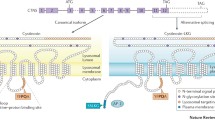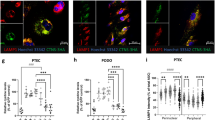Abstract
Background
Cystinosis is an ultrarare disorder caused by mutations of the cystinosin (CTNS) gene, encoding a cystine-selective efflux channel in the lysosomes of all cells of the body. Oral therapy with cysteamine reduces intralysosomal cystine accumulation and slows organ deterioration but cannot reverse renal Fanconi syndrome nor prevent the eventual need for renal transplantation. A definitive therapeutic remains elusive. About 15% of cystinosis patients worldwide carry one or more nonsense mutations that halt translation of the CTNS protein. Aminoglycosides such as geneticin (G418) can bind to the mammalian ribosome, relax translational fidelity, and permit readthrough of premature termination codons to produce full-length protein.
Methods
To ascertain whether aminoglycosides permit readthrough of the most common CTNS nonsense mutation, W138X, we studied the effect of G418 on patient fibroblasts.
Results
G418 treatment induced translational readthrough of CTNSW138X constructs transfected into HEK293 cells and expression of full-length endogenous CTNS protein in homozygous W138X fibroblasts.
Conclusions
Reduction in intracellular cystine indicates that the CTNS protein produced is functional as a cystine transporter. Interestingly, similar effects were seen even in W138X compound heterozygotes. These studies establish proof-of-principle for the potential of aminoglycosides to treat cystinosis and possibly other monogenic diseases caused by nonsense mutations.






Similar content being viewed by others
References
Town M, Jean G, Cherqui S, Attard M, Forestier L, Whitmore SA, Callen DF, Gribouval O, Broyer M, Bates GP, van’t Hoff W, Antignac C (1998) A novel gene encoding an integral membrane protein is mutated in nephropathic cystinosis. Nat Genet 18:319–324. https://doi.org/10.1038/ng0498-319
Gahl WA, Tietze F, Butler JD, Schulman JD (1985) Cysteamine depletes cystinotic leucocyte granular fractions of cystine by the mechanism of disulphide interchange. Biochem J 228:545–550
Jezegou A, Llinares E, Anne C, Kieffer-Jaquinod S, O’Regan S, Aupetit J, Chabli A, Sagne C, Debacker C, Chadefaux-Vekemans B, Journet A, Andre B, Gasnier B (2012) Heptahelical protein PQLC2 is a lysosomal cationic amino acid exporter underlying the action of cysteamine in cystinosis therapy. Proc Natl Acad Sci U S A 109:E3434–E3443. https://doi.org/10.1073/pnas.1211198109
Ariceta G, Lara E, Camacho JA, Oppenheimer F, Vara J, Santos F, Munoz MA, Cantarell C, Gil Calvo M, Romero R, Valenciano B, Garcia-Nieto V, Sanahuja MJ, Crespo J, Justa ML, Urisarri A, Bedoya R, Bueno A, Daza A, Bravo J, Llamas F, Jimenez Del Cerro LA (2015) Cysteamine (Cystagon®) adherence in patients with cystinosis in Spain: successful in children and a challenge in adolescents and adults. Nephrol Dial Transplant 30:475–480. https://doi.org/10.1093/ndt/gfu329
Ivanova EA, De Leo MG, Van Den Heuvel L, Pastore A, Dijkman H, De Matteis MA, Levtchenko EN (2015) Endo-lysosomal dysfunction in human proximal tubular epithelial cells deficient for lysosomal cystine transporter cystinosin. PLoS One 10:e0120998. https://doi.org/10.1371/journal.pone.0120998
Gaide Chevronnay HP, Janssens V, Van Der Smissen P, N’Kuli F, Nevo N, Guiot Y, Levtchenko E, Marbaix E, Pierreux CE, Cherqui S, Antignac C, Courtoy PJ (2014) Time course of pathogenic and adaptation mechanisms in cystinotic mouse kidneys. J Am Soc Nephrol 25:1256–1269. https://doi.org/10.1681/ASN.2013060598
Sansanwal P, Sarwal MM (2012) p62/SQSTM1 prominently accumulates in renal proximal tubules in nephropathic cystinosis. Pediatr Nephrol 27:2137–2144. https://doi.org/10.1007/s00467-012-2227-4
Shotelersuk V, Larson D, Anikster Y, McDowell G, Lemons R, Bernardini I, Guo J, Thoene J, Gahl WA (1998) CTNS mutations in an American-based population of cystinosis patients. Am J Hum Genet 63:1352–1362. https://doi.org/10.1086/302118
McGowan-Jordan J, Stoddard K, Podolsky L, Orrbine E, McLaine P, Town M, Goodyer P, MacKenzie A, Heick H (1999) Molecular analysis of cystinosis: probable Irish origin of the most common French Canadian mutation. Eur J Hum Genet 7:671–678. https://doi.org/10.1038/sj.ejhg.5200349
Burke JF, Mogg AE (1985) Suppression of a nonsense mutation in mammalian cells in vivo by the aminoglycoside antibiotics G-418 and paromomycin. Nucleic Acids Res 13:6265–6272
Taranta A, Petrini S, Palma A, Mannucci L, Wilmer MJ, De Luca V, Diomedi-Camassei F, Corallini S, Bellomo F, van den Heuvel LP, Levtchenko EN, Emma F (2008) Identification and subcellular localization of a new cystinosin isoform. Am J Physiol Ren Physiol 294:F1101–F1108. https://doi.org/10.1152/ajprenal.00413.2007
Langman CB, Greenbaum LA, Sarwal M, Grimm P, Niaudet P, Deschenes G, Cornelissen E, Morin D, Cochat P, Matossian D, Gaillard S, Bagger MJ, Rioux P (2012) A randomized controlled crossover trial with delayed-release cysteamine bitartrate in nephropathic cystinosis: effectiveness on white blood cell cystine levels and comparison of safety. Clin J Am Soc Nephrol 7:1112–1120. https://doi.org/10.2215/cjn.12321211
Feng YX, Copeland TD, Oroszlan S, Rein A, Levin JG (1990) Identification of amino acids inserted during suppression of UAA and UGA termination codons at the gag-pol junction of Moloney murine leukemia virus. Proc Natl Acad Sci U S A 87:8860–8863
Blanchet S, Cornu D, Argentini M, Namy O (2014) New insights into the incorporation of natural suppressor tRNAs at stop codons in Saccharomyces cerevisiae. Nucleic Acids Res 42:10061–10072. https://doi.org/10.1093/nar/gku663
Roy B, Friesen WJ, Tomizawa Y, Leszyk JD, Zhuo J, Johnson B, Dakka J, Trotta CR, Xue X, Mutyam V, Keeling KM, Mobley JA, Rowe SM, Bedwell DM, Welch EM, Jacobson A (2016) Ataluren stimulates ribosomal selection of near-cognate tRNAs to promote nonsense suppression. Proc Natl Acad Sci U S A 113:12508–12513. https://doi.org/10.1073/pnas.1605336113
Xue X, Mutyam V, Thakerar A, Mobley J, Bridges RJ, Rowe SM, Keeling KM, Bedwell DM (2017) Identification of the amino acids inserted during suppression of CFTR nonsense mutations and determination of their functional consequences. Hum Mol Genet 26:3116–3129. https://doi.org/10.1093/hmg/ddx196
Gahl WA, Reed GF, Thoene JG, Schulman JD, Rizzo WB, Jonas AJ, Denman DW, Schlesselman JJ, Corden BJ, Schneider JA (1987) Cysteamine therapy for children with nephropathic cystinosis. N Engl J Med 316:971–977. https://doi.org/10.1056/nejm198704163161602
Gahl WA, Balog JZ, Kleta R (2007) Nephropathic cystinosis in adults: natural history and effects of oral cysteamine therapy. Ann Intern Med 147:242–250
Andrzejewska Z, Nevo N, Thomas L, Chhuon C, Bailleux A, Chauvet V, Courtoy PJ, Chol M, Guerrera IC, Antignac C (2016) Cystinosin is a component of the vacuolar H+-ATPase-ragulator-Rag complex controlling mammalian target of rapamycin complex 1 signaling. J Am Soc Nephrol 27:1678–1688. https://doi.org/10.1681/asn.2014090937
Rega LR, Polishchuk E, Montefusco S, Napolitano G, Tozzi G, Zhang J, Bellomo F, Taranta A, Pastore A, Polishchuk R, Piemonte F, Medina DL, Catz SD, Ballabio A, Emma F (2016) Activation of the transcription factor EB rescues lysosomal abnormalities in cystinotic kidney cells. Kidney Int 89:862–873. https://doi.org/10.1016/j.kint.2015.12.045
Helip-Wooley A, Park MA, Lemons RM, Thoene JG (2002) Expression of CTNS alleles: subcellular localization and aminoglycoside correction in vitro. Mol Genet Metab 75:128–133. https://doi.org/10.1006/mgme.2001.3272
Nudelman I, Glikin D, Smolkin B, Hainrichson M, Belakhov V, Baasov T (2010) Repairing faulty genes by aminoglycosides: development of new derivatives of geneticin (G418) with enhanced suppression of diseases-causing nonsense mutations. Bioorg Med Chem 18:3735–3746. https://doi.org/10.1016/j.bmc.2010.03.060
Nudelman I, Rebibo-Sabbah A, Cherniavsky M, Belakhov V, Hainrichson M, Chen F, Schacht J, Pilch DS, Ben-Yosef T, Baasov T (2009) Development of novel aminoglycoside (NB54) with reduced toxicity and enhanced suppression of disease-causing premature stop mutations. J Med Chem 52:2836–2845. https://doi.org/10.1021/jm801640k
Nudelman I, Rebibo-Sabbah A, Shallom-Shezifi D, Hainrichson M, Stahl I, Ben-Yosef T, Baasov T (2006) Redesign of aminoglycosides for treatment of human genetic diseases caused by premature stop mutations. Bioorg Med Chem Lett 16:6310–6315. https://doi.org/10.1016/j.bmcl.2006.09.013
Bidou L, Bugaud O, Belakhov V, Baasov T, Namy O (2017) Characterization of new-generation aminoglycoside promoting premature termination codon readthrough in cancer cells. RNA Biol 14:378–388. https://doi.org/10.1080/15476286.2017.1285480
Wang D, Belakhov V, Kandasamy J, Baasov T, Li SC, Li YT, Bedwell DM, Keeling KM (2012) The designer aminoglycoside NB84 significantly reduces glycosaminoglycan accumulation associated with MPS I-H in the Idua-W392X mouse. Mol Genet Metab 105:116–125. https://doi.org/10.1016/j.ymgme.2011.10.005
Xue X, Mutyam V, Tang L, Biswas S, Du M, Jackson LA, Dai Y, Belakhov V, Shalev M, Chen F, Schacht J, JB R, Baasov T, Hong J, Bedwell DM, Rowe SM (2014) Synthetic aminoglycosides efficiently suppress cystic fibrosis transmembrane conductance regulator nonsense mutations and are enhanced by ivacaftor. Am J Respir Cell Mol Biol 50:805–816. https://doi.org/10.1165/rcmb.2013-0282OC
Clay RD, Darmady EM, Hawkins M (1953) The nature of the renal lesion in the Fanconi syndrome. J Pathol Bacteriol 65:551–558
Silverblatt FJ, Kuehn C (1979) Autoradiography of gentamicin uptake by the rat proximal tubule cell. Kidney Int 15:335–345
Vandewalle A, Farman N, Morin JP, Fillastre JP, Hatt PY, Bonvalet JP (1981) Gentamicin incorporation along the nephron: autoradiographic study on isolated tubules. Kidney Int 19:529–539
Funding
This work was supported by operating grants from the Cystinosis Research Foundation, the Kidney Foundation of Canada, and the Canadian Institutes of Health Research and an infrastructure grant from the Fonds de Recherche en Santé du Québec to the Research Institute of the McGill University Health Centre. Emma Brasell was the recipient of a graduate studentship award from the Cystinosis Research Foundation. Dr. Paul Goodyer is the recipient of a James McGill Research Chair.
Author information
Authors and Affiliations
Contributions
EJB participated in the experimental design; performed the cell culture, qPCR, cell transfection, and intracellular half-cystine measurements; analyzed the results; and participated in the manuscript preparation.
LLC participated in the experimental design; performed the cell culture, qPCR, Western immunoblotting, plasmid construction, and intracellular half-cystine measurements; analyzed the results; and participated in the manuscript preparation.
REK participated in the experimental design.
JHS performed the cell transfection.
RL performed the cell culture.
DMI participated in the experimental design.
PG participated in the experimental design, data analysis, and manuscript preparation.
Corresponding author
Ethics declarations
Ethics compliance
All primary cell lines used in this article were subject to IRB approval from the RI-MUHC REB (protocol: 2018-2922).
Conflict of interest
The authors declare that they have no conflicts of interest.
Electronic supplementary material
Suppl. Fig. 1.
Half-cystine in CTNSW138X/W138X fibroblasts after treatment with different concentrations of G418. Half-cystine was measured after 24-hour exposure to G418 (200ug/mL) and normalized to total cell protein in A. WG1012 (n = 1-6) and B. WG1986 (n = 2-3) CTNSW138X/W138X fibroblasts. (AI 1993 kb)
Suppl. Fig. 2.
Time course of half-cystine in a CTNSW138X/W138X fibroblast line after treatment with G418. Half-cystine was measured after exposure to G418 (200ug/mL) for 24-72 hours and normalized to total cell protein in WG1012 CTNSW138X/W138X fibroblasts (n = 1). (AI 1773 kb)
Rights and permissions
About this article
Cite this article
Brasell, E.J., Chu, L., El Kares, R. et al. The aminoglycoside geneticin permits translational readthrough of the CTNS W138X nonsense mutation in fibroblasts from patients with nephropathic cystinosis. Pediatr Nephrol 34, 873–881 (2019). https://doi.org/10.1007/s00467-018-4094-0
Received:
Revised:
Accepted:
Published:
Issue Date:
DOI: https://doi.org/10.1007/s00467-018-4094-0




